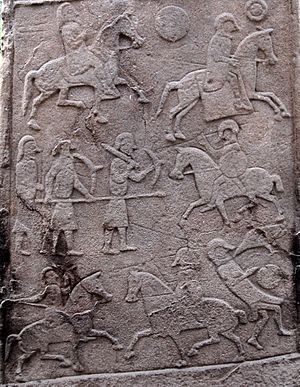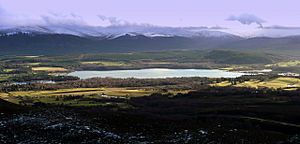Battle of Dun Nechtain facts for kids
Quick facts for kids Battle of Dun Nechtain |
|||||||
|---|---|---|---|---|---|---|---|
| Part of the Pictish-Northumbrian conflicts | |||||||
 Pictish symbol stone depicting what was once generally accepted to be the battle |
|||||||
|
|||||||
| Belligerents | |||||||
| Pictland | Northumbria | ||||||
| Commanders and leaders | |||||||
| Bridei III | Ecgfrith † | ||||||
The Battle of Dun Nechtain (also known as the Battle of Nechtansmere) was a major fight in ancient Scotland. It happened on May 20, 685. The battle was between the Picts, led by their King Bridei Mac Bili, and the Northumbrians, led by their King Ecgfrith.
At this time, Northumbria was a powerful kingdom in northern Britain. King Ecgfrith wanted to keep his control over other groups, including the Picts. But the Picts and other nations were starting to rebel.
King Ecgfrith decided to lead his army against the Picts. He wanted to show them who was in charge. However, the Picts used a clever trick. They pretended to run away, drawing the Northumbrian army into a trap.
The battle took place near a lake called Linn Garan. Historians aren't completely sure where this was. For a long time, people thought it was near a village called Dunnichen in Angus. But newer research suggests it might have been further north, near Dunachton by Loch Insh.
The Picts won a huge victory. King Ecgfrith was killed, and most of his army was destroyed. This battle was a turning point. It meant the Picts became truly independent from Northumbria. Northumbria never got its power back in the north of Britain.
Contents
Why Did the Battle Happen?
Northumbria's Growing Power
In the 600s AD, the Northumbrians were slowly taking over more land to the north. They even captured Edinburgh around 638. This meant they controlled lands south of the River Forth.
North of the Forth lived the Picts. The Picts were also under Northumbrian rule for a while. This control continued even when Ecgfrith became king in 670.
Pictish Rebellions and Challenges
Soon after Ecgfrith became king, the Picts tried to break free. This led to the Battle of Two Rivers. Ecgfrith won that battle, and the Pictish king was replaced by Bridei mac Bili.
But Northumbria's power started to weaken around 679. The Irish records show that another kingdom, Mercia, defeated Ecgfrith. His brother was killed in that battle.
The Picts, led by King Bridei, also started attacking Northumbrian strongholds. They attacked places like Dunnottar in 680 and Dundurn in 682. These attacks showed that Bridei was a strong leader.
Religious Differences and Raids
King Bridei also attacked the Orkney Islands in 681. At this time, the Northumbrian church was changing. It had followed the traditions of the Columban church from Iona. But in 664, it switched its loyalty to the Roman Church.
The Northumbrians even set up a new church area for the Picts. This was at Abercorn. Bridei was very loyal to the Iona church. He probably didn't like the Northumbrian church moving into his lands.
Ecgfrith also sent his armies to Ireland in 684. They attacked and destroyed many churches there. This made people like the historian Bede very upset. These actions showed that Ecgfrith was dealing with many challenges to his rule.
How the Battle Unfolded
Historians believe King Ecgfrith attacked the Picts in 685 to get back his control. The most detailed, but still short, description of the battle comes from Bede's book, The Ecclesiastical History of the English People. Irish and Welsh records also give some details.
Ecgfrith's friends, including a bishop named Cuthbert, told him not to attack. But Ecgfrith didn't listen.
The Picts, led by King Bridei, used a clever trick. They pretended to run away. This made Ecgfrith's Northumbrian army chase them into a trap. The battle happened on Saturday, May 20, 685, near a lake in the mountains. The Northumbrian army was completely defeated, and King Ecgfrith was killed.
Where Did the Battle Happen?
The exact place of the battle is still a mystery. For a long time, it was called the Battle of Nechtansmere. This name comes from an old English word meaning 'Nechtan's lake'. The Welsh records call it Gueith Linn Garan, which means 'Battle of Crane Lake'. This suggests a lake was definitely involved.
Bede, the historian, only said it happened 'in straits of inaccessible mountains'. This doesn't give us much help.
The Irish records are more useful. They call the location Dún Nechtain, meaning 'Nechtan's Fort'. This name still exists today in two places.
Dunnichen: The Traditional Site
In the early 1800s, a historian named George Chalmers suggested Dunnichen in Angus as the battle site. He noted that old maps showed a small lake there, called 'Dunnichen Moss'. Local stories also linked this area to famous battles.
The Aberlemno stone, which shows a battle scene, is often used as proof for Dunnichen. This stone is only 3 miles (5 km) north of Dunnichen. However, the stone was carved much later than the battle. So, it might not be directly about Dun Nechtain.
Dunachton: A Newer Idea
In 2006, historian Alex Woolf suggested a different place: Dunachton in Badenoch. He pointed out that Dunnichen doesn't really have "inaccessible mountains." Dunachton, however, is in a more mountainous area near Loch Insh. Like Dunnichen, Dunachton's name also comes from 'Nechtan's Fort'. While Dunnichen can't be completely ruled out, Dunachton seems to fit the descriptions better.
What Happened After the Battle?
The defeat at Dun Nechtain was a huge blow to Northumbria. Bede wrote that the Picts got back all their lands that the Northumbrians had taken. Any Northumbrians who didn't run away from Pictish land were killed or made slaves.
The Northumbrian church in Pictish lands was abandoned. The bishop, Trumwine, and his monks fled. This stopped the Roman Catholic Church from expanding into Scotland for a while.
Even though there were more battles between the Northumbrians and Picts later, the Battle of Dun Nechtain was the most important. It made sure that the Picts would remain independent from Northumbria forever.
Images for kids




